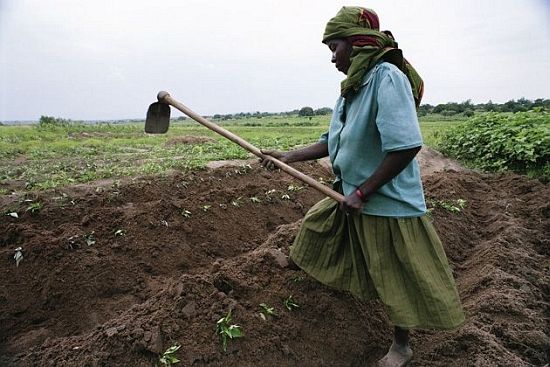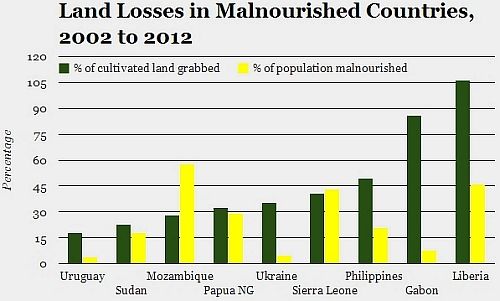Welcome to DU!
The truly grassroots left-of-center political community where regular people, not algorithms, drive the discussions and set the standards.
Join the community:
Create a free account
Support DU (and get rid of ads!):
Become a Star Member
Latest Breaking News
General Discussion
The DU Lounge
All Forums
Issue Forums
Culture Forums
Alliance Forums
Region Forums
Support Forums
Help & Search
Global Land And Water Grabbing
Abstract
Societal pressure on the global land and freshwater resources is increasing as a result of the rising food demand by the growing human population, dietary changes, and the enhancement of biofuel production induced by the rising oil prices and recent changes in United States and European Union bioethanol policies. Many countries and corporations have started to acquire relatively inexpensive and productive agricultural land located in foreign countries, as evidenced by the dramatic increase in the number of transnational land deals between 2005 and 2009. Often known as “land grabbing,” this phenomenon is associated with an appropriation of freshwater resources that has never been assessed before. Here we gather land-grabbing data from multiple sources and use a hydrological model to determine the associated rates of freshwater grabbing. We find that land and water grabbing are occurring at alarming rates in all continents except Antarctica. The per capita volume of grabbed water often exceeds the water requirements for a balanced diet and would be sufficient to improve food security and abate malnourishment in the grabbed countries. It is found that about 0.31 × 1012 m3?y?1 of green water (i.e., rainwater) and up to 0.14 × 1012 m3?y?1 of blue water (i.e., irrigation water) are appropriated globally for crop and livestock production in 47 × 106 ha of grabbed land worldwide (i.e., in 90% of the reported global grabbed land).
Societal pressure on the global land and freshwater resources is increasing as a result of the rising food demand by the growing human population, dietary changes, and the enhancement of biofuel production induced by the rising oil prices and recent changes in United States and European Union bioethanol policies. Many countries and corporations have started to acquire relatively inexpensive and productive agricultural land located in foreign countries, as evidenced by the dramatic increase in the number of transnational land deals between 2005 and 2009. Often known as “land grabbing,” this phenomenon is associated with an appropriation of freshwater resources that has never been assessed before. Here we gather land-grabbing data from multiple sources and use a hydrological model to determine the associated rates of freshwater grabbing. We find that land and water grabbing are occurring at alarming rates in all continents except Antarctica. The per capita volume of grabbed water often exceeds the water requirements for a balanced diet and would be sufficient to improve food security and abate malnourishment in the grabbed countries. It is found that about 0.31 × 1012 m3?y?1 of green water (i.e., rainwater) and up to 0.14 × 1012 m3?y?1 of blue water (i.e., irrigation water) are appropriated globally for crop and livestock production in 47 × 106 ha of grabbed land worldwide (i.e., in 90% of the reported global grabbed land).
http://www.pnas.org/content/early/2013/01/02/1213163110.abstract
[IMG]
 [/IMG]
[/IMG]
In 2010, a former Wall Street trader flew into war-torn Sudan to negotiate a deal with a thuggish general. He had his eye on a 1 million acre tract of fertile land fed by a tributary of the Nile in the southern section of the country, a region that later claimed its independence as South Sudan. The investor, who planned to profit by developing and exporting agricultural commodities, boasted about how the region's instability was a principal variable in his financial model: "This is Africa," he told reporter McKenzie Funk, who shadowed him for a riveting piece in Rolling Stone (PDF). "The whole place is like one big mafia. I'm like a mafia head."
Over the last decade (and especially during the last four years) wealthy nations have increasingly brokered deals for huge swathes of agricultural land at bargain prices in developing countries, installed industrial-scale farms, and exported the resulting bounty for profit. According to the anti-hunger group Oxfam International, more than 60 percent of these "land grabs" occur in regions with serious hunger problems. Two-thirds of the investors plan to ship all the commodities they produce out of the country to the global market. And droughts, spikes in food and oil prices, and a growing global population have only made the quest for arable land more urgent, and the investments that much more alluring.
[IMG]
 [/IMG]
[/IMG]
Data within the PNAS report also indicate that the "mafia head" approach of targeting vulnerable countries for investments is not just the strategy of a lone land-grabbing cowboy, but standard practice. It's easier to wrest land and displace small-scale farmers in countries with a weak rule of law, according to Oxfam. In many cases, the land is developed to export crops or commodities for biofuels, and in other cases, left to sit idle so it can increase in value before it's sold.
Of the countries that lost the highest percentages of their cultivated land, nine out of 10 have malnourishment rates of 5 percent or more (see chart below). And according to Foreign Policy and Fund for Peace's Failed States Index, all the states in the graph below, with the exception of Uruguay, are categorized as unstable.
Of the countries that lost the highest percentages of their cultivated land, nine out of 10 have malnourishment rates of 5 percent or more (see chart below). And according to Foreign Policy and Fund for Peace's Failed States Index, all the states in the graph below, with the exception of Uruguay, are categorized as unstable.
[IMG]
 [/IMG]
[/IMG]
http://www.motherjones.com/blue-marble/2013/01/top-land-grabbing-countries
InfoView thread info, including edit history
TrashPut this thread in your Trash Can (My DU » Trash Can)
BookmarkAdd this thread to your Bookmarks (My DU » Bookmarks)
0 replies, 1582 views
ShareGet links to this post and/or share on social media
AlertAlert this post for a rule violation
PowersThere are no powers you can use on this post
EditCannot edit other people's posts
ReplyReply to this post
EditCannot edit other people's posts
Rec (1)
ReplyReply to this post